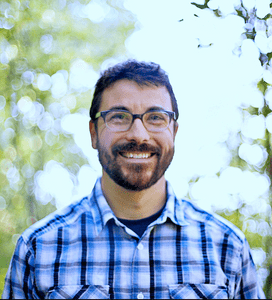Prof. Trapani joined Amherst College in 2011. He is an Associate Professor in the Biology Department and also contributes to the Neuroscience program. He has chaired the Biology department since July this year. His research involves the use of the model organism larval zebrafish to look at how hair cells encode information which leads to the creation of behavior like a startle response. Prof. Trapani contributes to the life of the college by mentoring students like myself. This year, he is also part of the Committee of Six, a group of six faculty elected to represent the interests of other faculty members. It is chaired by the school’s President, Biddy Martin. He worked with his Biology department colleagues to create the Diversity, Equity, and Inclusion webpage for the Biology department.

What motivated you to create this new page in the Biology department?
The college is committed to ensuring students thrive in their academics, social lives, and other spaces in between. Faculty and staff are aware of the differences that are present among different groups of students taking their courses and that improvements are needed to create a structure where all students can thrive, especially those from underrepresented communities. In STEM disciplines, this group has traditionally been referred to as Underrepresented Minorities (URM), a term that is not accurate as these students are not necessarily minorities in their desire to be STEM majors. I prefer the term developed by David Asai, “PEER” (Persons Excluded because of their Ethnic groups and Race).
The number of PEER students that graduate with a STEM major is fewer than those that start off interested in STEM and the reasons for this attrition have been shown to be due to equity and inclusion issues rather than the level of preparation. In order for PEERs to feel welcomed, supported, and able to thrive, we must focus on the structures within our STEM departments and courses.
We made this webpage to show that we are committed to working towards full equity and inclusion in our major, our courses, our research labs, our advising, etc., to show the actions that we have taken as a department and to hold us accountable. We also hope that this webpage will create a model for other departments to create similar prominent webpages highlighting their commitments to doing the work.
How did the department approach this issue before the page was created?
The page solidified the department’s efforts to make our major and our courses more inclusive. In addition to individual efforts of faculty in their labs and courses, there are some larger efforts including the Incubator program, the Summer Bridge Program, and Being Human in STEM, a course created by Prof. Sheila Jaswal with the support of other faculty and staff as an aftermath of the 2015 Amherst Uprising. We have also added a diversity, equity, and inclusion requirement to our major course requirements and worked to diversify our seminar series by including speakers from different backgrounds, asking them to not only talk about their research but also encourage them to share some of their journey through STEM. There are other changes throughout our department as well, but more needs to be done and it needs to be part of a larger college commitment to this prominent problem within the STEM disciplines.
What would you tell the PEERs?
I appreciate all the hard work that students have put in to advocate for their needs, and faculty and staff need to take on this challenge and work to remove any and all barriers to your ability to thrive in STEM. Do not settle for anything less than what you need. We hope that courses like Being Human in STEM will encourage students to reach out to faculty members for support, but we need more than just the HSTEM course and the summer programs that are not available to all students that might benefit from them. This problem needs to be addressed beyond the faculty and the department level. Systemic and institutional commitments and support are needed to fully combat this issue within STEM at Amherst. For example, I could imagine the Q center, Writing center, and possibly an additional center based on equity and inclusion in STEM coming together to support students and their ability to thrive and graduate from STEM majors at Amherst College.
I thank Prof. Trapani for taking the time to answer our questions and Sabina for suggesting edits for this piece. As a woman of color in STEM, I understand that the journey of seeking Diversity, Inclusion, and Equity requires concerted efforts. I hope you, the reader, will play a role by educating yourself. I recommend the film Picture a Scientist that was shared by AWIS this week. Furthermore, linked below are some articles recommended by Prof. Trapani: